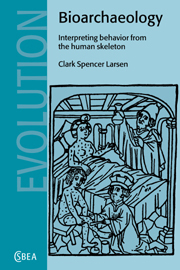Book contents
- Frontmatter
- Contents
- Acknowledgments
- 1 Introduction
- 2 Stress and deprivation during the years of growth and development and adulthood
- 3 Exposure to infectious pathogens
- 4 Injury and violent death
- 5 Activity patterns: 1. Articular and muscular modifications
- 6 Activity patterns: 2. Structural adaptation
- 7 Masticatory and nonmasticatory functions: craniofacial adaptation
- 8 Isotopic and elemental signatures of diet and nutrition
- 9 Historical dimensions of skeletal variation: tracing genetic relationships
- 10 Changes and challenges in bioarchaeology
- References
- General index
- Site index
7 - Masticatory and nonmasticatory functions: craniofacial adaptation
Published online by Cambridge University Press: 05 June 2012
- Frontmatter
- Contents
- Acknowledgments
- 1 Introduction
- 2 Stress and deprivation during the years of growth and development and adulthood
- 3 Exposure to infectious pathogens
- 4 Injury and violent death
- 5 Activity patterns: 1. Articular and muscular modifications
- 6 Activity patterns: 2. Structural adaptation
- 7 Masticatory and nonmasticatory functions: craniofacial adaptation
- 8 Isotopic and elemental signatures of diet and nutrition
- 9 Historical dimensions of skeletal variation: tracing genetic relationships
- 10 Changes and challenges in bioarchaeology
- References
- General index
- Site index
Summary
Introduction
The influence of environment and behavior on skull morphology was discussed quite early. In the fifth century BC, Herodotus remarked on apparent differences in cranial robusticity between Persians and Egyptians: ‘The skulls of Persians are so weak that if you so much as throw a pebble at one of them, you will pierce it; but the Egyptian skulls are so strong that a blow with a large stone will hardly break them.’ He interpreted these differences as being related to the lifelong exposure of the head to the sun and increased cranial thickening as a result in Egyptians but not in Persians.
The influence of environment and behavior, no matter how specious the interpretation, has been only minimally considered in discussions of cranial morphology in archaeological remains since Herodotus drew the above conclusions about cranial robusticity. Beginning in the eighteenth century, osteologists relied on craniofacial variation for determining population history and classification, with little attention given to the biological significance of observed patterns (see Armelagos, 1968; Armelagos et al., 1982; Carlson, 1976a, 1976b; Carlson & Van Gerven, 1977, 1979). As in investigations of long bone morphology, there has been a gradual reorientation from typological/historical to processual analyses. This new emphasis focusses on underlying processes that influence cranial morphology, revealing the adaptive and behavioral significance of variation.
- Type
- Chapter
- Information
- BioarchaeologyInterpreting Behavior from the Human Skeleton, pp. 226 - 269Publisher: Cambridge University PressPrint publication year: 1997
- 3
- Cited by



